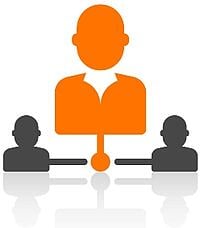
In today’s buyers’ market it is crucial to have an understanding of the processes the buyer goes through when making a decision. The buyers’ journey takes them through a number of stages and you need to ensure you are there to educate and provide the relevant resources and content your buyer needs as they move through the process.
Is your content marketing up to scratch? Many businesses are struggling with their content as it is almost entirely focused on the final purchase stage of the customer lifecycle. They focus on company information and product information and wrongly assuming that everyone is ready to make a purchase right there and then. Whereas in fact statistics show that only about 4% of visitors to your website are actually ready to buy.
So how do you ensure your content is working for the other 96%? Your content should play a critical role in every stage of the buying cycle to help create awareness, generate leads and convert leads into customers. Mapping your content to the stages of the buying cycle is key. Consider your buyer personas and ensure you have the right type of content for every stage of the buying cycle.
The three main stages of a typical buying cycle are:
1. Awareness Stage
Prospects are conducting initial research and trying to figure out what companies are out there and what the options are. Firstly you need to make sure that you have a good SEO and keyword strategy so that when a potential customer is searching on the various terms your company gets found by search engines.
In the awareness stage, prospects are trying to figure out what options exist and get a deeper understanding of the marketplace. At this stage, you are trying to educate your prospect, not about your company but about the need for your product/ solutions.
Blogging is a great type of content to use at the awareness stage. It will help you get found in search results and help position you as a subject matter expert once they get to your website. Guide your prospects to content rich landing pages with calls-to-action, for example, videos or how-to guides and Ebooks. Social media is also useful to promote your content and to start building awareness and rapport with prospects.
2. Interest / Consideration Stage
It is at this stage that a prospect has identified a need and will then go and conduct some research around potential solutions or partners.
Customers in this stage are interested in learning more about a topic. They are willing to watch webinars and download “expert guides,” and are prepared to give you their information in return. This is important, because you need to make sure you are capturing their information so you can nurture them through the final stage and turn them into a customer.
They’re looking for information to help them make a better decision once they are ready to purchase. This is the stage where lead generation happens. The type of content that is needed for this stage of the buyer’s journey would be webinars, whitepapers, research studies and comparison guides.
3. Evaluation / Purchase Stage
Once a prospect has considered their options, they begin to narrow down the choices and ultimately determine who to buy from.
How do you know a buyer is in the decision stage? If they are requesting demos, signing up for free trials, wanting to read case studies or needing detailed product information – they are in the decision stage of the buyer’s journey. These customers have identified their need for a solution to their problem, and are looking for supporting documentation and endorsements from you and your existing customers.
They will probably have narrowed down their choices to two or three vendors and this is where having relevant content throughout the buyer’s journey may help you stand out from your competition. If you have nurtured them through the buyer’s journey, they should trust you and be more likely to buy from you.
Creating content for existing customers
Remember – don’t ignore your existing customers and don’t stop engaging with them! That is a fatal error! Continue to show your knowledge and expertise and keep adding value to the relationship. After all, you want them to be satisfied and remain your customers for the long haul, eventually becoming brand evangelists. Create content around user guides or FAQs or hold seminars or webinars on best practice.
To conclude, mapping the most appropriate content to each stage in the buying cycle will help you speak to the individual needs of each prospect so you're having the right conversation with the right people at the right time.
Intellegentia can help you with your inbound marketing strategy to ensure you are reaching your target customers and engaging them as they move through the buying cycle. To learn about how you can maximise your content marketing and lead generation, join us at our Content Marketing Planning Workshop.
.png?width=250&height=76&name=Intellegentia%20Logo%20(MAIN).png)
